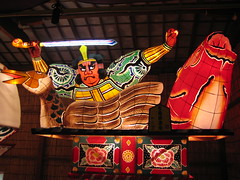
On Friday, I with some friends from work to the Mitama Matsuri at Yasukuni Jinjya. This is a very interesting trip all around, because it is a traditional Japanese Matsuri (festival) that takes place in a temple that honors those who have fallen during wartime (Yasukuni Temple.) The temple itself has been the center of, in a peripherial manner, a long-standing controversy between Japan and its neighbors, mainly China and Korea. The main controversy is not over the temple itself, but visits to the temple by Prime Minister Koizumi, who has been going there for the past few years. He says that he goes to the temple as an individual, and not a representative of the government.
2. The meaning of the Japanese Prime Minister going there. The perception issue has to do with what Yasukuni is about. I am absolutely positive that what it is about depends greatly upon who you are. I do not claim to speak for the Japanese view. My guess is that they see it as a way to honor their fallen dead, and a way to remember some part of what the Japanese people are about. Less of “Japan Nationalism taking over the Eastern World” (as implemented in the “Great East-Asian Co-Prosperity Sphere”) and more of Japan fighting not to lose what makes the Japanese essentially so, the chrysanthemum of the East, working together, sacrificing the individual for the greater good, the sakura blossom and hanayome young Japanese bride in her Kimono. The poetry and koans of Basho, and the Bushido of Nobunaga uniting the country. The Chinese and Koreans surely see Yasukuni as a celebration of the darker Imperial side of Japan rushing into their ancient territory, trying to impose their culture and take their lands, and the horrors committed in the name of the new Japanese Imperialism. I have been told that, up until World War II, only the dead victors in battle where honored at Yasukuni, but that changed with World War II. There are people honored there that were put on trail for war crimes. It is easy for me to see how that would offend the victims of those crimes. The second issue is that when Koizumi, the Prime Minister, goes to visit Yasukuni, it is seen in other countries as an official visit. Even though he says he goes as an individual and not as a representative of the government, they feel that there is an implicit approval of the hard-line conservatives in power. Given the vast troubles Japan has had in the past of admitting to war crimes, admitting to the use of comfort women, the troubles they have had with revisionist history entering (or non revisionist history not entering) their textbooks, I can also understand the view that these vists are a slap to the face when such a high ranking official goes to glorify war criminals.
Personally, I don’t think I have a place to judge. I try to see how both sides might feel, but I know I’m American, and I don’t think I can judge from either vantage point. It was a period of war, and terrible things happen during war. Terrible things are done in the name of war, and I think people, individuals, do things that they would never do in another time and place. Nationalism only adds fuel to the fire, allowing for even more extreme justification and action. That is one reason that I really fear for America today, which seems to be becoming more and more Nationalistic as time goes on. That is another topic though.
I have wanted to go to Yasukuni for a long time, so I could see myself what the place is like. This trip was amazingly interesting because it showed me two very different views of Yasukuni.
First, there was the typical Japanese Matsuri. I always like Matsuri (festivals) in Japan. I love the tradition, reflected in the gold-fish catching shops and eateries, and people dressed in Yukata (traditional Japanese style clothing) and Getta, the Japanese wooden clog-shoes that make such a haunting sound as they clatter over the asphault.
The mix of this tradition with the modern is amazing. Cell phones, spot lights, and electric lanterns. Cotton candy machines and glow-in-the-dark toys. Japan is a very interesting country where the ultra-modern and ulta-traditional come into conflict and a beautiful display of clashing culture that somehow works results.
This festival at Yasukuni was no different. It is a Mitama Matsuri, the Mitama are spirits. I don’t know much about the spirits and how this festival works with that. There was a great dance around a central pillar though, with old and young alike walking around and making intricate hand motions. My friends from work were wowwed by one of the male instructors, saying that “his hand movements are just amazing”. I have to admit that the subtlety was lost on me, but the dance itself was great, with people from all walks of life joining in together, and rythmically walking around and waving their arms to the music.
Again, I particularly liked on young woman in fashionable sunglasses (at night) performing a century-old dance (which seemed to me somehow similar to an O-bonn dance. But I don’t honestly know.)
On the other hand, we briefly went into the museum part of the shrine. I was really surprised by what I saw there. First off, when you enter there is a dominanating restoration of a Zero fighter plane. It took five other planes together to create the recreation. I was impressed, but somehow the artillery guns behind it gave me a sense of … glorification for a past military might.
I didn’t feel the sadness that I felt seeing these things that I felt at Washington and the Vietname memorial. There are some statues there with soldiers and their guns, and those made me feel a sort of terror, seeing the soldiers who didn’t want to fight, who had lost brothers and friends. At Yasukuni, there was more of a sense of pride in these machines. Of course, I must stress that I did not read much of the plaques around the machinery, just skimmed over them, so my impressions might be totally off. I also did not venture far into the museum, or watch the movie that they had about the war.
I did go to the gift shop. It was surreal. There was all sorts of memorabilia – Japanese flags, the Hinomaru, which is always a strong national symbol. Strangest of all, for me, was the “Navy’s Curry” box that you could buy. You too can have the “Yokosuka” (seat of the naval power) curry. It just seems odd. I couldn’t imagine MREs (or whatever the Meal-Ready-to-Eat equivilant was of the Vietnam era) for sale at the Vietnam Memorial in Washington D.C. Maybe I’m not trying hard enough though, because I’m sure if money could be made selling it, someone would be selling it.
Anyway, it was very strange. I would like to go back to Yasukuni and see it when it is less of a carnival-like atmosphere. I am absolutely positive that the people there Friday night were not thinking about the war, not thinking about the Greater East Asian Co-Prosperity Sphere, were not thinking of trying to take over their neighboring humans and brothers, and were not, most of all, thinking of spirits. They were having a good time with friends, eating a lot of Tako-yaki, dancing around a bit old songs (which probably do have to do with spirits, but perhaps in the same way that “Casper, the friendly ghost” does) and trying to score a kiss with their girlfriend. It was not an evil thing at all, and I certainly wouldn’t want people to think that festivals like that should be protested. I’m sure someone does protest against them though.The strangest memory of the night for me (closely followed by the couple, the young girl in short shorts, intently reading about the Japanese battleship and the names of those that died on it) was the image of a family with a young child, mother and child in Yukata, father in Western clothes, looking at the Zero. I like that image. They didn’t seem to be thinking of past glory, or feeling proud, or perhaps not even sad. They seemed to just be, like me, looking at a piece of history, and wondering how it all fit in, perhaps admiring a nice piece of engineering. (Myself, I’m partial to the Spitfire
.)

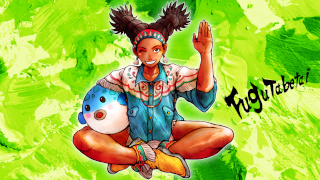
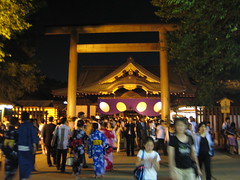
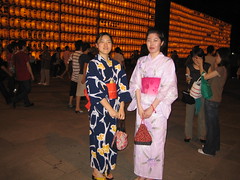
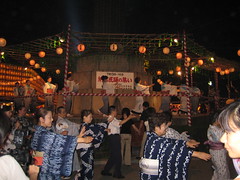
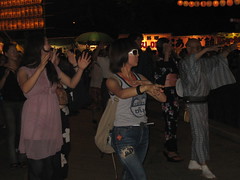
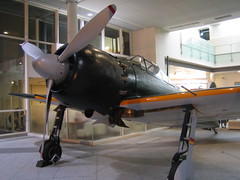
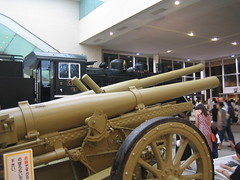
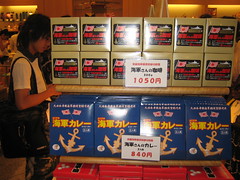
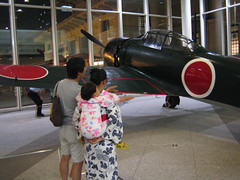
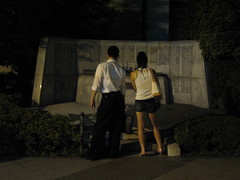
Leave a Reply